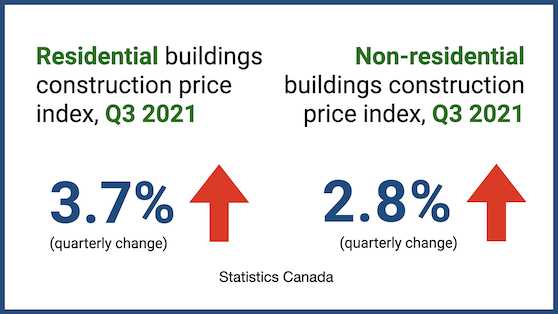
Business
Features
News
Drop in lumber didn’t help – building construction price indexes Q3 2021
October 28, 2021 | By Anthony Capkun
“Plastic resin is used in various materials, from electrical wire to engineered wood and PVC piping products.”

October 28, 2021 – Statscan reports residential building construction price growth slowed in the third quarter, amounting to 3.7% following a 7.6% increase in the second quarter.
Similarly, non-residential building construction price growth slowed to 2.8% after reaching 3.9% last quarter—the highest level in 13 years.
The impacts of the drop in price of lumber from the Q2 reference period (May 15, 2021)—when the price was at its recent peak—did not translate to comparable price decreases in the Building Construction Price Index (BCPI) in Q3, Statscan adds.
The decline in the sales of lumber in the manufacturing, wholesale trade and retail trade sectors—as well as the decreasing value of building permits for residential building construction—provided signals that the demand-induced price increase for lumber eased in Q3.
Wood, plastics and composites continued to be the largest contributor to the price change for residential building construction in the 11-city composite. Increases in the price of plastic resin (as measured by the Industrial Product Price Index)—attributed to manufacturing capacity disruptions from severe weather events earlier this year—also contributed to the increase of residential building construction costs.
Plastic resin is used in various materials, from electrical wire to engineered wood and PVC piping products. Non-structural wood products, such as windows and doors, were also cited by contractors as rising in price, despite the overall decrease in lumber cost.
The next largest contribution to the change in residential building construction prices was the increased cost of concrete and its associated components, including reinforcing steel. The rise in the price of concrete contributed the most to higher costs of building high-rise apartments, as concrete is one of the primary building materials in high-rise residential construction.
Contractors cited increasing fuel and steel reinforcement prices, as well as truck driver shortages, as reasons for higher prices of concrete products.
Similar to the previous quarter, concrete, followed by metal fabrication products, contributed the most to the change in the cost of construction of non-residential buildings in the 11-city composite.
For both types of products, contractors said recent increases in raw steel prices are attributable to supply constraints that include longer delivery times and shorter price guarantees.
Increases in labour costs, attributed to skilled trade shortages across the sector, were also noted by contractors. Demand-induced price pressures have also contributed to the continued strength in the price growth of concrete and metal fabrication products within the non-residential sector.
Calgary (+5.4%), Edmonton (+4.9%) and Toronto (+4.5%) had the largest quarterly growth in residential building construction costs—all three mostly driven by single-detached houses and townhomes. In Calgary, contractors reported the cost and availability of materials, labour rate increases and the skilled labour shortage had an impact on the construction market.
Increases in the non-residential building sector, continues Statscan, were led by higher construction costs in Toronto (+4.2%) Ottawa (+4.1%) and Moncton (+3.3%).
Building construction costs for residential construction increased by 20.3% year-over-year in the third quarter for the 11-city composite—the highest year-over-year increase recorded since 2018, notes Statscan. The cities with the largest year-over-year change this quarter were Calgary (+34.4%), Ottawa (+28.8%) and Edmonton (+24.7%).
Non-residential construction building costs rose 8.3% year-over-year, which was the largest gain since the third quarter of 2008. The cities with the largest year-over-year change this quarter were Ottawa (+13.6%), Toronto (+11.6%) and Montreal (+9.7%).
Print this page